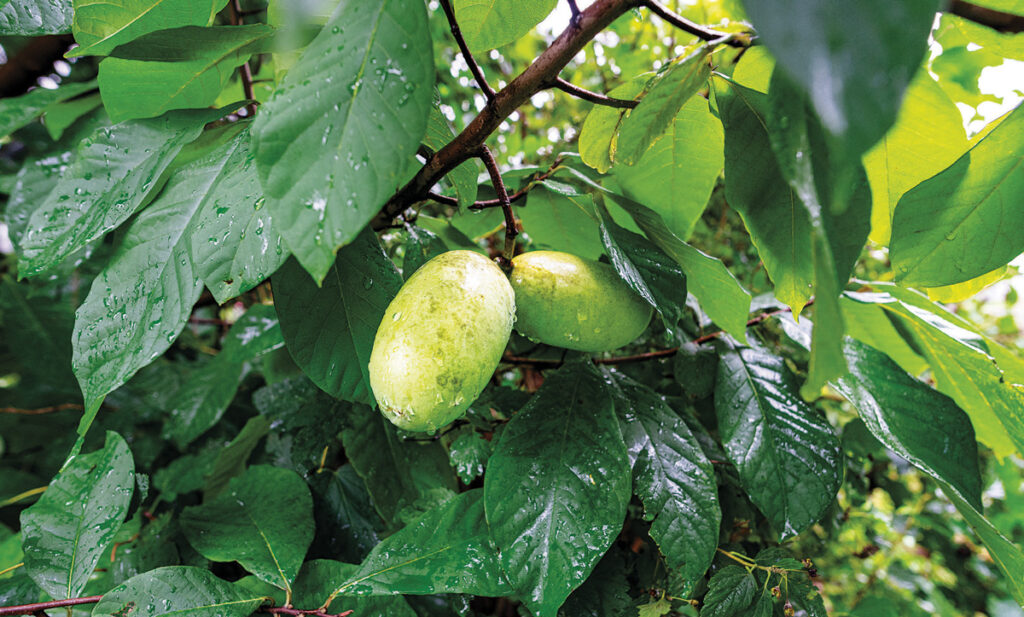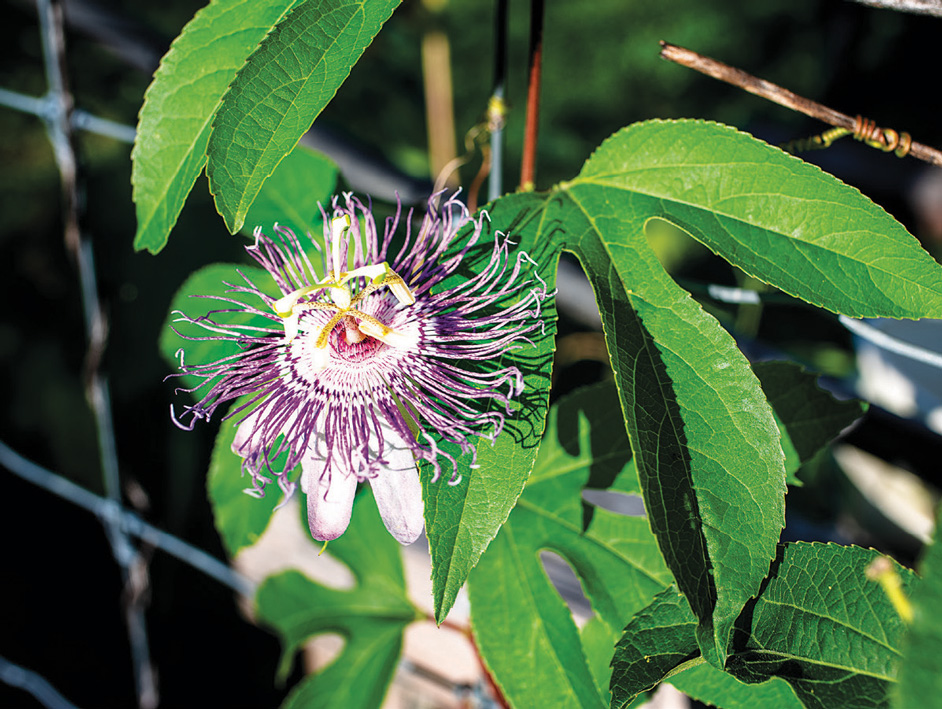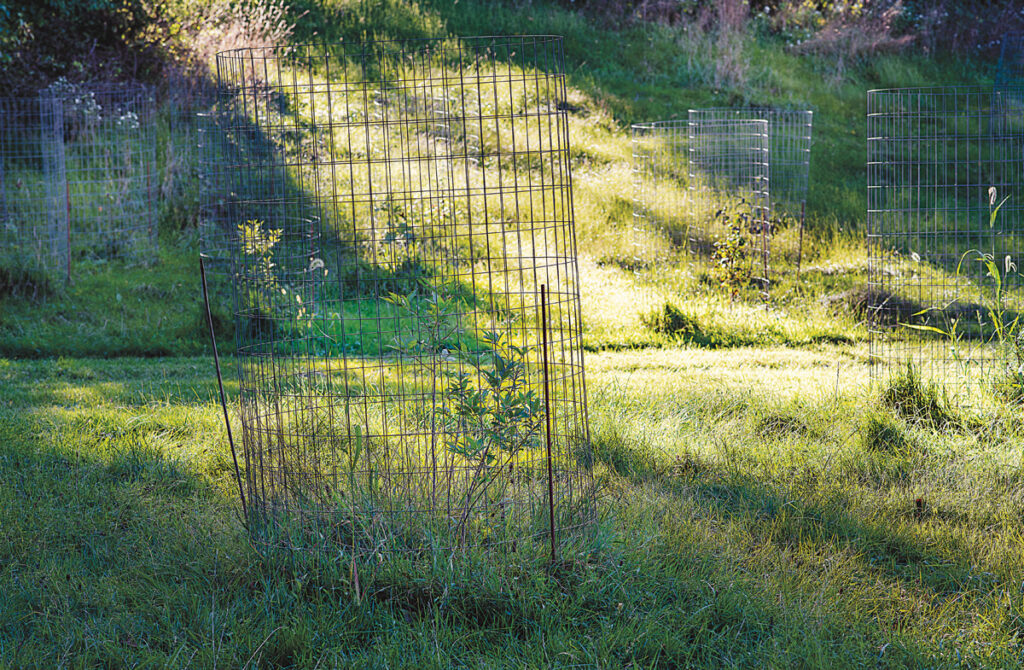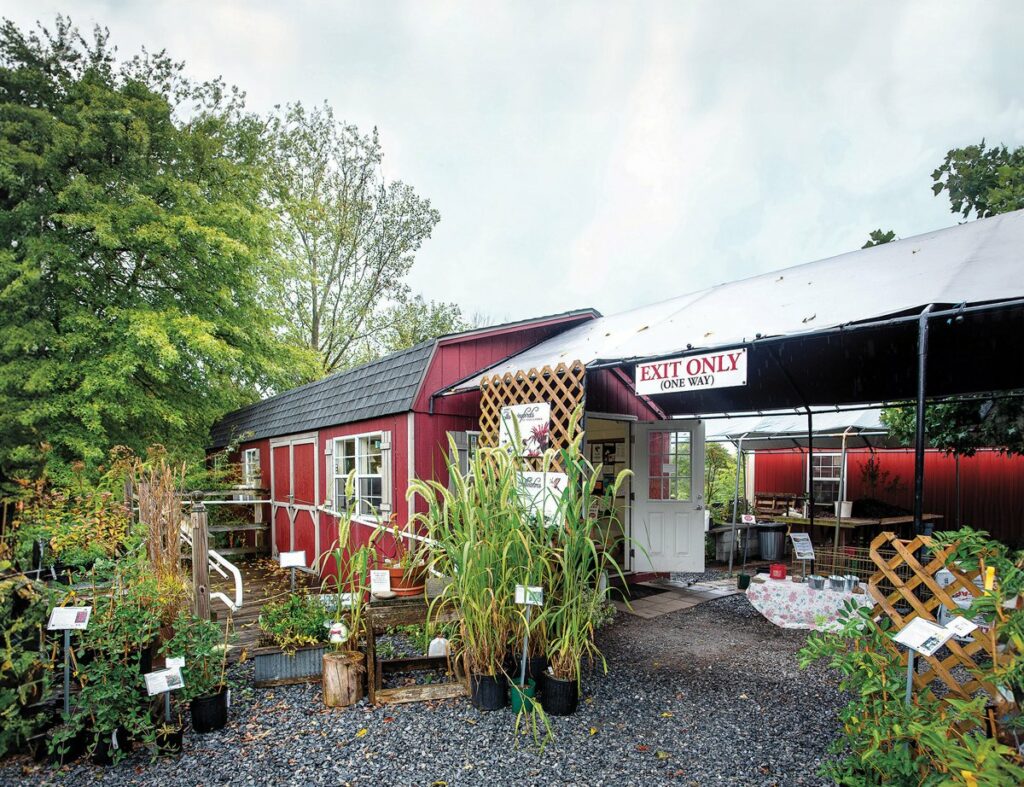
PHOTOS BY ROBERTO QUEZADA-DARDÓN
IMAGINE WALKING INTO YOUR BACKYARD and filling your hands with fresh blackberries, bursting with summer freshness. Picture a hedgerow dotted with dark purple elderberries, waiting to be turned into syrup or jam to sustain you in the winter. Consider backyard shrubs bearing hazelnuts, year after year.
With a little foodscaping, you could put your outdoor space to work with food-producing trees, and shrubs to feed your family. And you wouldn’t be alone, either, as many homeowners and organizations are turning to native edible landscaping for its multitude of benefits to the environment and the home cook.
At Bear Creek Organics in Luzerne County, owner Richard Mitchell Jr. focuses on planting ecological, edible landscapes for homeowners.
“Instead of just having a vegetable garden, we’re designing and installing the entire area around someone’s home to be food-producing,” Mitchell says.
Mitchell says foodscaping with native fruit trees and bushes offers many benefits. “It looks beautiful, supports native ecology, and helps pollinators,” he says. That ecological ripple effect goes beyond planting a seasonal garden, designed to produce for just one year. This approach provides delicious food that can be grown within the context of a homeowner’s space—right outside your door.

THE SHORTEST SUPPLY CHAIN
“It’s a no-brainer that we should take control of our food source, and the quality of our food,” Mitchell says, adding that supply chain issues during the pandemic were a turning point for many in considering where their food comes from.
“Everything comes from far away, and we live in a ‘just-in-time’ market,” Mitchell says, meaning that the supply chain is designed to deliver our food precisely at the moment when we need it. “The smallest issue can mean we can’t get the food we need.”
Growing food in your own backyard is the shortest supply chain you’ll ever find, Mitchell says. You’ll know where it’s coming from, how it was grown, and can select the variety that you and your family want to eat.
EDIBLE DESIGN
The design process is really important and Mitchell says he works to understand and nurture a client’s goals. He urges homeowners to think about the types and varieties of food they’d like to grow. Mitchell suggests raspberries and blueberries, or native trees that produce fruits and nuts, such as pawpaws and chestnuts. He encourages customers to explore the fruit trees, shrubs, and other plants at his edible landscaping nursery.
While big-box stores may sell a few types of fruit trees and bushes, Mitchell says his nursery offers more varieties suited to the backyard gardener and the local climate, as well as those selected for higher quality and taste.
“I always look for native first,” he says, since they’ll take off faster in the local landscape and require less intervention. Some native varieties, such as pawpaws and elderberries, are also deer-resistant.
Mitchell designs each space and develops a site-specific plan to recommend plants that will do best in that landscape’s growing conditions. Pawpaw trees, for example, can tolerate shade and bear a tropical-tasting fruit, he adds. Elderberry produces a large, beautiful shrub that grows eight to 10 feet tall and almost as wide, and can handle shade or moist conditions. It will deliver tiny white flowers followed by clusters of berries. The berries aren’t to be eaten raw but are much more suited for jams and jellies, Mitchell says. They can also be made into therapeutic syrups and tinctures to help boost the immune system all year round.
“People tell me ‘I grew up eating these [flavors] at my grandparents,’” Mitchell says of customers who spy the elderberries along with currants and gooseberries at his nursery.
CHOOSING NATIVE SPECIES
Jared Rosenbaum is a field botanist who co-owns Wild Ridge Plants, a native plant nursery in Warren County, NJ, with wife Rachel Mackow. On wildridgeplants.com the duo list info and photos on native plants they offer, which customers can order for farm pickup or mail order. They offer advice for those looking to learn more about native planting, and consultations for more extensive projects.
“We grow a wide variety but we’re especially interested in plants that have cultural uses—both medicinal and edible,” says Rosenbaum, who is also the author of Wild Plant Culture: A Guide to Restoring Edible and Medicinal Native Plant Communities.
He says there’s been incredible momentum in the native plant movement over the last three decades. “There’s been this real shift in understanding how people’s home lands are interknit with wild landscapes and our environment.”
Rosenbaum explains that native plants are adapted to our climate, rainfall, and seasonal patterns. “Unlike a plant from another country, you don’t have to coddle them and keep them from freezing or keep them wet when it’s dry.”
Planting natives also connects a homeowner with the land around them to better understand the landscape—attuning to the seasonal cycles of plants and when to harvest.
“Native plants offer this chance to do something positive that has local and global effects,” he adds. “It’s a really hopeful way to be a caretaker for the Earth.”
Rosenbaum says in Colonial days there was an aggressive conversion of the landscape due to intense logging and the introduction of European crops.
“There was a concerted effort to transform the landscape into a familiar European landscape,” he says, adding there was a “general disregard of edible plants and wildlife the Indigenous people cultivated.”
While Colonial people used some native plants and herbs, it often wasn’t reflected in how the land was treated and managed, he adds.

RESTORING THE LAND
Eli Stogsdill, project manager of Monocacy Farm Project in Hanover Township, says the process of European colonization and settlement disrupted the ecological systems.
“Old-growth forests were clear cut and land use changed dramatically in order to take the land and to develop an extractive, export-oriented economy,” Stogsdill adds.
Today, the Monocacy Farm Project, a small nonprofit educational farm founded by the School Sisters of St. Francis, is actively planting and growing native, food-producing shrubs around the farm. They’re moving forth with this effort in partnership with restoration projects throughout the Lehigh Valley watershed. The farm works to grow a healthy community through mutual care for the land along Monocacy Creek. For example, they recently established a young windbreak planting of persimmons and hazelnuts on the west side of the veggie fields to reduce stress and moisture loss from the west wind.
Additionally, the farm grows food for local emergency food systems, offers a community garden program, shares seasonal produce through a pick-your-own program, and educates learners of all ages and abilities. It’s a hub of activity during the summer and fall.
They’ve drawn inspiration from The Puddle Garden, a children’s book about native plants by Rosenbaum, and transformed a low-lying area of the farm into an agroforestry demonstration puddle garden. The space is filled with fruit and nut trees such as pecan, hickory, pawpaw, persimmon, and plum. While a grafted plum tree in the garden has already started to bear fruit, it will require several seasons to see the other plantings develop enough growth to support fruit production.


“Planting trees is an exercise in both urgency and patience,” Stogsdill says. “Trees are an essential part of a liveable future we want to co-create, and given the right conditions they can grow much taller and live much longer than us.”
By caring for seedlings of many trees (chestnut, hickory, pawpaw) Stogsdill hopes “to plant and be fed by the forests of the future.” Stogsdill also intertwines native, seasonal crops like Blue Shackamaxon beans, and perennial passion flowers, alongside these larger plantings.
Most recently, the Monocacy Farm Project collaborated with Edge of the Woods Native Plant Nursery in Orefield to plant a riparian buffer that features more than 700 carefully selected tree varieties along the Monocacy Creek. The planting incorporates “high-value native nut and fruit trees as a long-term perennial strategy to add diversity and climate resilience to our ongoing educational and food production efforts,” Stogsdill says.
Edge of the Woods is working with the farm and the Sisters to manage the project over five years to ensure that the trees have proper care and maintenance during that time. Such oversight is a key part of ensuring that the plantings will flourish and their impact will be felt on the surrounding environment. Not only will the riparian buffer protect the water source, but the selected tree varieties will provide food value, Tantsits says.
PLANNING YOUR PLATE
So how can a homeowner bring these flavors into their backyard?
Sue Tantsits, horticulturist and co-owner of Edge of the Woods, says planning is key.
Tantsits and co-owner Louise Schaefer opened Edge of the Woods in 2003 because they wanted people to be able to find native plants in a walk-in retail setting.
“People wanted to bring this back to their own personal landscapes—whether that’s a small front yard or several acres.”

At the nursery, customers can look and learn and determine how best to use their landscape to sustain them.
“The one thing people must realize: When you grow a vegetable garden, you need that garden to produce in one season. Those peppers and tomatoes need rich soil to produce,” she says. “When you’re growing edible natives, you want these to be sustainable for the long-term.”
Look at what your landscape offers, and realize that each corner could offer different growing conditions. Which areas get a lot of sun or shade? Are you working with moist or dry soil, or clay? Then consider your taste buds.

Fruits like American field strawberries and American cranberries can grow in Eastern Pennsylvania, and so can red/black raspberries, blackberries, and American plums. Passion fruit vine smells wonderful, attracts bees, and produces fruit. With a lot of sugar added, chokeberries can make a wonderful jam, Tantsits says. Blueberries are a delicious addition but need very specific, acidic soil.
Chestnut trees start to produce at 20 feet and offer a good crop each season. Hickory nuts from shagbark and shellbark hickory trees offer edible nuts if you have the ambition to crack them open, she adds. Stogsdill oversees such types of hickory trees growing along the creek, thanks to Tantsits’s input.
People use mint for culinary purposes, as an ornamental accent, and a deer deterrent. Wild leeks make for wonderful culinary plants.
Tantsits says fruit trees like American plums and persimmons will do quite nicely in this area, though the fruit they produce may be different in size and taste from the varieties at the grocery store.

PLANT IT!
Eli Stogsdill offers a few tips for adding food-producing trees and plants:
Evaluate your growing space. Consider the sun, water, soil, size, site prep, taste, time, weed pressure, pest pressure, and protection it may offer.
Many trees are successfully planted while dormant. Plant in the late fall or early spring to allow them time to get established before the stress of a growing season.
Bigger is not always better. A large tree may suffer more transplanting stress as the roots are disturbed. In some cases, planting a younger, smaller tree with an intact root system may allow for faster, more robust growth and ultimately a healthier, long-lived tree.
Tantsits says this past growing season was a great one for persimmons in particular, and the tree in her backyard offered up delicious half-dollar-sized fruit, compared to the supermarket’s baseball-sized options.
“You’re going to take what you can get in any given year,” she says.
DESIGNING FOR YOUR PALATE
Rosenbaum says when it comes to native plants there’s “a whole world of flavors to discover.”
He notes juneberries, which offer up a taste that’s a cross between apples, cherries, and blueberries. “You’ll never find them in a supermarket but they’re so good.”
Native persimmons are so “super soft and gooey that you could never sell [them] in a supermarket,” says Rosenbaum. But when ripe right off your own tree, they deliver a delicious flavor reminiscent of honey, apricot, and nectar. The fruit is too delicate to make the trip from tree to supermarket, but if you’re growing them, you can pick them at the peak of freshness.
Rosenbaum says varieties of bee balm, a member of the mint family, are great to use as herbs or in teas. They offer a flavor with notes of citrus, oregano, and rose. Plus, the perennial flower adds a pop of color to the landscape, and supports hummingbirds and local pollinators.
For nut-producing plants, try American hazelnut shrubs, or a Shagbark Hickory tree (a relation of pecans but with a richer flavor). Looking for greens in your design plan? Ostrich ferns will deliver fiddleheads in springs; ramps or wild leeks might be an option for a spot with shade.
He also likes to grow groundnuts (or starchy tubers) that look like small potatoes. They offer a flavor between a chickpea and a potato. Rosenbaum says the little tubers grow like pearl necklaces underground with a twining, flowering vine that can grow up an elderberry or hazelnut bush. Rosenbaum harvests them throughout the year and fries them in a skillet until the outer skin gets crispy.
PLAN FOR SHORT, MEDIUM, AND LONG-TERM GOALS
When you’re developing a planting plan, you don’t have to do it all at one time. Build your landscape over time by learning about native plants and how they combine together, Tantsits says. Add to it as space and budget allow.
Raspberries are easy to grow, and a great food source. They can offer nice hedgerows, though they’re not ideal for planting close to the house, Tantsits says.
Raspberries may be the easiest investment and fastest turnaround, and may get fruit in its first year, Mitchell adds. Elderberry also produces quickly. Other edible options might take a little more time.
“Plan for short, medium, and long-term goals,” Mitchell says. An apple tree could take five years to get going; nut trees could take 10.
“My dad and I wanted to plant fruit trees when I was 8,” Mitchell remembers. “The year I bought my first fruit tree [for the nursery] he said ‘Imagine what our backyard would’ve looked like if we’d planted those apple trees that year.’”
Worst-case scenario when foodscaping: It’s a learning lesson. Best case? You’re growing beautiful, healthy food.
Mitchell says, “There’s an old saying, ‘The best time to plant a fruit tree is 10 years ago—the next-best time is now.’”




